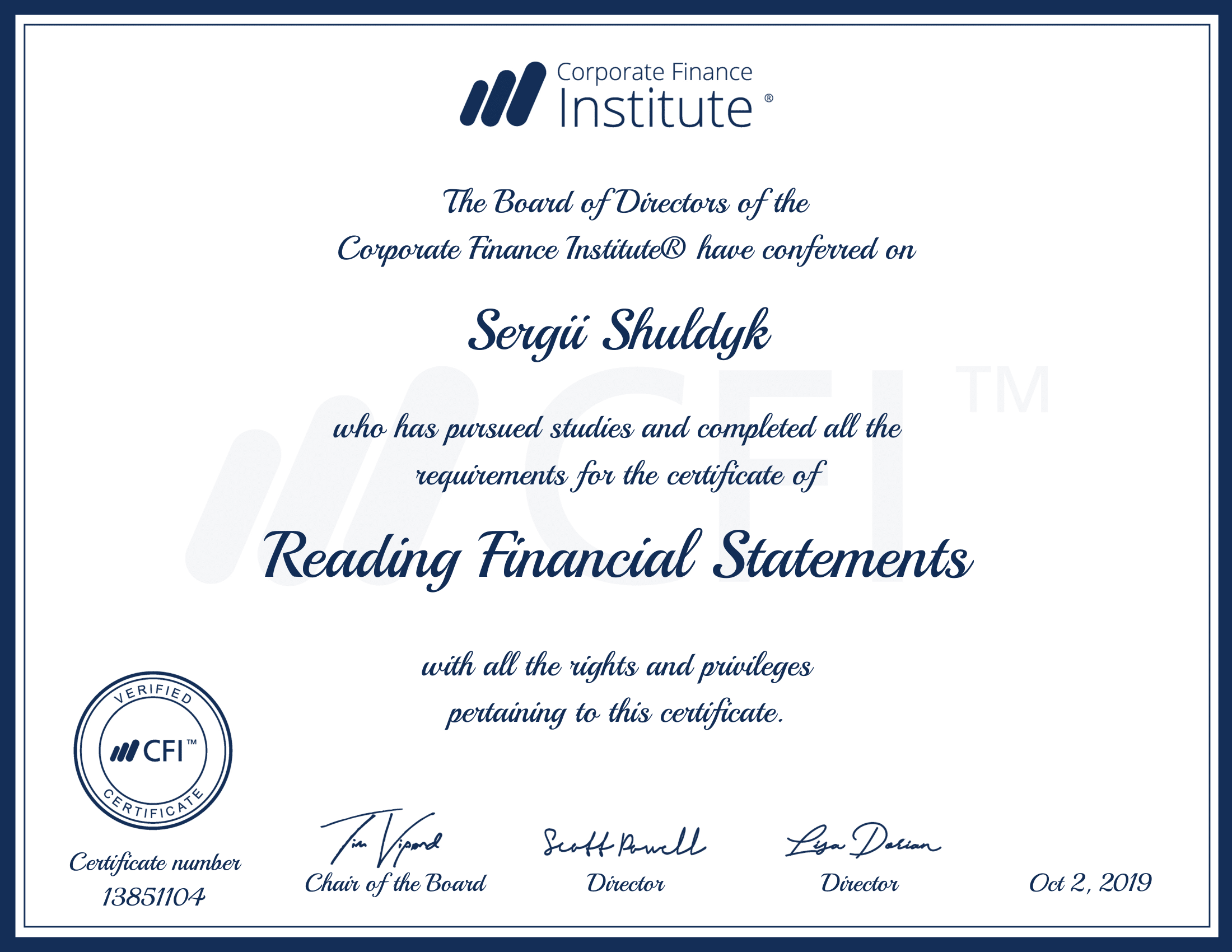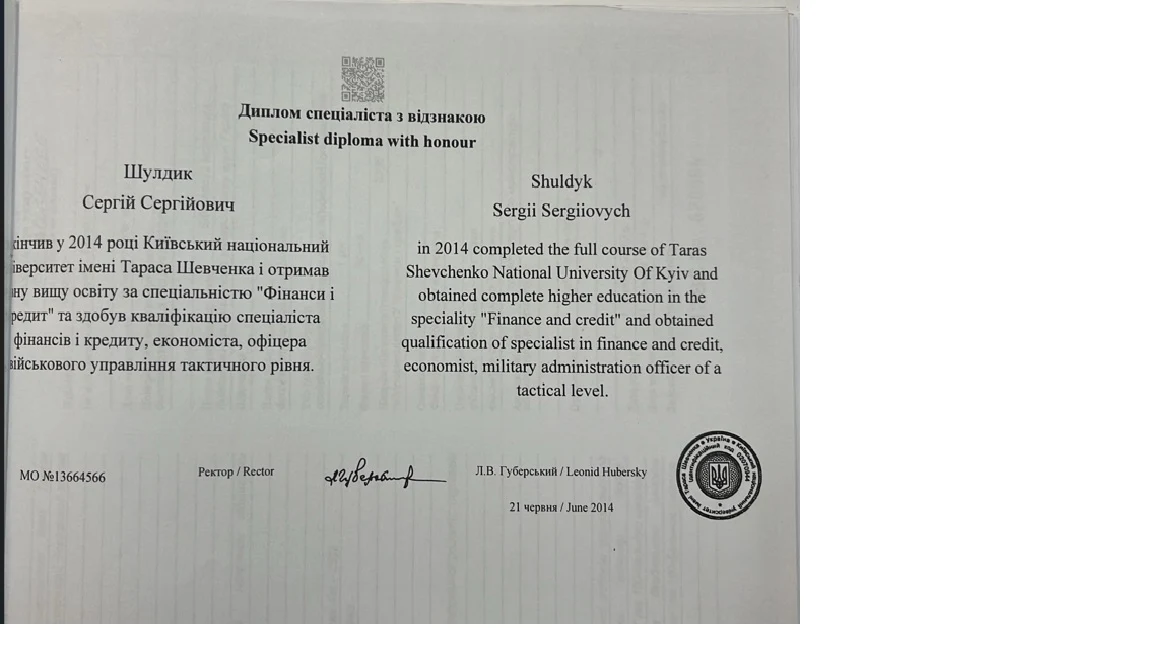Author's Posts
.webp)
How Viora Build Saved 20 Hours a Week for the Operations Manager and Focused on Scaling
From financial chaos to clarity: how Viora Build turned control into a growth driver.
Financial management in the construction business is a constant game with dozens of variables: you need to account for material costs, contractor payments, team salaries, taxes, purchases, advances, and completion certificates.
Any mistake in the numbers can cost the company its margin, missed deadlines, and the nerves of the entire team.
This is exactly what Viora Build faced when the number of projects and the volume of work began to grow rapidly. Financial management was done in Google Sheets, but the growing business demanded something more.
We tracked all expenses manually, and this constantly led to mistakes. We needed a system that gives a clear picture and helps plan growth. — Simon, Operations Manager at Viora Build
The solution was the implementation of Finmap and the involvement of a financial manager who took over accounting, reporting, and financial planning.
In this article, you will learn:
- how the company completely changed its approach to finances and freed up 20 hours a week for the operations manager;
- how automation helped avoid cash gaps and clearly see the profitability of each project;
- what became the decisive factor for scaling the business and what insights the team gained from this process.
Read on — and you will see that finances can be simple, and business management — predictable.
About the Client: Who Is Viora Build
Viora Build is a construction company from Portugal that specializes in building premium and luxury villas, as well as multi-story residential buildings.
The company works with private investors and developers who expect not only high construction quality but also transparency in financial processes.
A key feature of Viora Build’s business is its project-based work format. This means that several projects with different budgets, contractors, payment schedules, and financial plans are managed simultaneously.
In such a situation, it is very easy to lose control:
- each project has separate purchases, completion certificates, and payments;
- changes in material costs directly affect profitability;
- it is necessary to ensure that there is always enough money in the accounts to settle with suppliers and staff.
The main driver of change was Simon. As an operations manager, he is responsible not only for controlling construction processes but also for the financial side: from budget allocation to profitability analysis.
However, despite having a professional team, before working with Finmap the company’s financial management was far from ideal.
Simon recalls that he felt the need for a system from the very first days at work, but changes could only be implemented once the company had grown.
When we grew, we had capital, we realized that we could afford it, and immediately hired a financial manager. Because without this person, there could be no talk of rapid business development at all. — Simon, Operations Manager at Viora Build
Thus, Viora Build reached the point where financial chaos began to hold back business growth — and it was time to act.
What Held Viora Build Back from Growing
When the company began to scale, it became clear: the old approach to finances no longer worked. Accounting in Google Sheets, manual data entry, and lack of systematization created chaos that slowed down growth.
We managed all expenses through Google Sheets… and none of it was automated, which naturally led to mistakes. — Simon, Operations Manager at Viora Build
Main Challenges
The situation was complicated by the fact that the company was managing several large projects at the same time, and any mistake in calculations could cost tens of thousands of euros.
We needed a person who could prepare proper P&L and Cash Flow reports, make breakdowns by months and quarters, handle financial planning, and prepare commercial proposals for investors. — Simon, Operations Manager at Viora Build
Why Change Became Inevitable
The company understood the need for automation from the very beginning, but as Simon says, everything came down to resources.
This moment became a turning point: financial chaos began to directly affect the speed of decision-making and the company’s growth.
How Viora Build Put Its Finances in Order
To get out of financial chaos, the company decided to act comprehensively. Hiring a financial manager, automating processes, and gradually shifting to more strategic management — these three steps became the key to transformation.
We always understood that this was necessary. It just always came down to resources. When we grew and had capital, we decided that the time had come. Because without this person, rapid business growth would have been impossible. — Simon, Operations Manager at Viora Build
Hiring a Financial Manager
The company hired a financial manager who took over management, preparation of P&L and Cash Flow reports, financial planning, and commercial proposals for investors.
Over time, he became the financial director and began performing more strategic tasks.
At first, we worked in the format of a financial manager: he categorized all operations, built reports. And now we are working on a deeper level in the format of a financial director, when he executes strategic decisions and provides us with reporting. — Simon, Operations Manager at Viora Build
Automation with Finmap
All financial operations were transferred from Google Sheets to Finmap. The system made it possible to manage operations by categories, see account balances, and get P&L and Cash Flow at any moment.
Delegating financial management to the financial manager was the only expectation — and he handled it. Now even more — he took the initiative and is also setting up an ERP system for us. — Simon, Operations Manager at Viora Build
ERP System Launch
The next step is integrating finance, procurement, and cost estimation into a single ERP system.
This will make it possible to fully synchronize purchase planning, cost control, and issuing completion certificates.
We started implementing ERP because without it the financial director finds it difficult to work. There must be coordination between the estimation department, procurement, and finance — otherwise it’s hard to develop the direction. — Simon, Operations Manager at Viora Build
What Viora Build Gained After Implementing Finmap
Already within the first two months of cooperation, the company felt significant changes. Financial management stopped being chaotic, and the management team received a clear picture across all projects.
Now we have an automated financial management system. We have a financial director who can answer any question at any moment. We control whether there will be a cash gap and can plan our finances without driving ourselves into a corner. — Simon, Operations Manager at Viora Build
Tangible Benefits for the Team
- Time savings:
Working with the financial director freed up at least 20 hours a week for me in finance. — Simon, Operations Manager at Viora Build
- Project transparency:
Now we can accurately calculate our project margins and, thanks to this, net profit. — Simon, Operations Manager at Viora Build
- Control and predictability:
We have a payment calendar. We clearly understand what is happening with the projects and which completion certificates need to be issued. — Simon, Operations Manager at Viora Build
- Department coordination:
The procurement department, finance, and estimations now work in sync. This saves time not only for the manager but for the entire management team.
Readiness for Scaling
The company now has not only control but also the tools for growth.
The next step is the launch of an ERP system, which will allow even more accurate cost forecasting and improve profitability.
This frees up time both for our director and for me as a manager. Now I can focus more on developing the company rather than on routine. — Simon, Operations Manager at Viora Build
Insights and Advice for Other Businesses
Collaboration with Finmap and the financial director became a turning point for Viora Build. The team not only organized the numbers but also saw how finances can become a strategic tool for growth.
Simon shares the key takeaways:
If there are any doubts about working with Finmap, I can say that communication is at a high level, the work is at a high level — so I can confidently recommend this company.
Insights from Viora Build
Advice for Entrepreneurs
- Don’t postpone financial systematization. If the business is growing, “manual” spreadsheets will sooner or later start slowing down development.
- Delegate finances to professionals. This frees up the manager’s time and gives the team clear rules of the game.
- Invest in analytics. P&L, Cash Flow, and the payment calendar are not just numbers — they are your growth plan.
- Look ahead. An ERP system and a CFO will help not only count money but also forecast the future.
What’s Next for Viora Build
The company is finalizing the implementation of its ERP system and preparing to scale the business into new regions.
Transparent finances and strategic management make it possible to take on larger projects without the fear of “getting lost” in the numbers.
Now we can plan our finances without driving ourselves into a corner. This gives confidence and freedom for growth. — Simon, Operations Manager at Viora Build
Frequently Asked Questions
- How long does it take to see the first results?
In the case of Viora Build, the first results came within the first month — the company received P&L, Cash Flow, balance control, and the ability to forecast payments.
- Is a financial director necessary if there is already an accountant?
Yes. An accountant works with past data, while a financial director plans the future and helps make strategic decisions.
- Is it difficult to implement automation within the team?
No. At Viora Build there was no resistance — everyone saw the benefits and quickly adapted to the new system.
- Does the investment in Finmap and a financial director pay off?
Yes. Simply freeing up 20 hours a week for the manager already covers the costs, not to mention the accuracy of financial decisions and avoiding cash gaps.
- What are the next steps after implementing financial management?
The next step is launching an ERP system to integrate finance, procurement, and estimations. This will further increase planning accuracy and project profitability.

Financial Management for IT Companies — Structure Your Cash Flow
How to bring order to finances: project-based management, multicurrency tracking, and cost control for scaling without cash gaps.
An IT company is more than just code, clients, and products. It’s also a complex financial system: payments in dollars, expenses in pounds, salaries in euros. Freelancers from around the world, subscriptions, servers, services, marketing. And on top of that — taxes, cash flow, payroll, and financial management reports.
As the company grows, the problems grow with it:
- clients pay in dollars, but the team gets paid in crypto;
- one project is profitable, another one is dragging the business down;
- there’s money in the account today — and a cash gap tomorrow. And no one understands why.
Financial management is your only tool for control, confidence, and growth.
It’s the only thing that answers the key questions:
- where the money goes;
- which direction is dragging the business down;
- when it’s time to scale — and when it’s better to hold the cash.
Let’s explore the real pain points IT companies face that drain their budgets — and the solutions that turn financial chaos into business growth.

Project-Based Financial Management Is the Foundation of Control in IT
We work on a dozen projects at once. Some are client-based, others internal. The same developers might be involved in different projects — at different rates. Expenses are tracked manually or not at all. As a result, it’s impossible to tell what generates profit and what simply consumes team time and money.
Sounds familiar? In IT, this isn’t the exception — it’s the norm. For IT companies, project-based financial management shouldn’t be just a convenience — it must be the foundation of financial literacy.
IT businesses often operate across multiple streams: web development, mobile apps, design, support, in-house products. And each of them is a separate project — or even dozens of smaller sub-projects.
When financial management is done only at the company level — not per project — you simply can’t see which of them are actually profitable, and which are dragging you down.
Without clear project analytics, you:
- can’t see which area generates 80% of your profit;
- can’t track where exactly the money goes — freelancers, contractors, or ads;
- can’t identify which projects are unprofitable and only drain your resources.
And most importantly — you make decisions without an objective financial picture.
Project-based financial management gives you visibility into spending, control over budgets, and insight into profitability for each project or sub-project.
It’s the key to timely and informed financial decisions.
McKinsey research highlights the cost of poor project control:
Only 0.5% of IT projects are completed on time, within budget, and with the expected financial return.
The same report presents striking numbers that show the consequences of lacking financial control:
- 59% of IT projects go over budget;
- 53% miss their deadlines;
- 56% deliver less profit than expected.
On average, if a project fails to meet even one of these parameters, costs increase by 75%, while profit drops by 39%.
Can you quickly spot such projects in your business? And are you confident you can cover the losses with reserves or more profitable streams?
That’s why project-based financial management shouldn’t live in a finance manager’s head or in spreadsheets — it must be part of a system that lets you see, analyze, and forecast everything in one place.
Project-Based Financial Management — the Finmap Way
In Finmap, projects are a dedicated layer of analytics for income, expenses, profit, and cash flow. You can:
- Create any number of projects and sub-projects (e.g. “CRM Development” → “Frontend”, “Backend”, “UI/UX”).
- See in real time how much each project earns, what it spends, and what its actual and planned profitability is.
- Compare performance across business streams and cut off unprofitable initiatives.
- Forecast results — just add potential future expenses, and you’ll instantly see how they affect the project’s profit.
- Delegate financial control of a project to a responsible manager by giving them access to only that project — without exposing the rest of the company’s data.
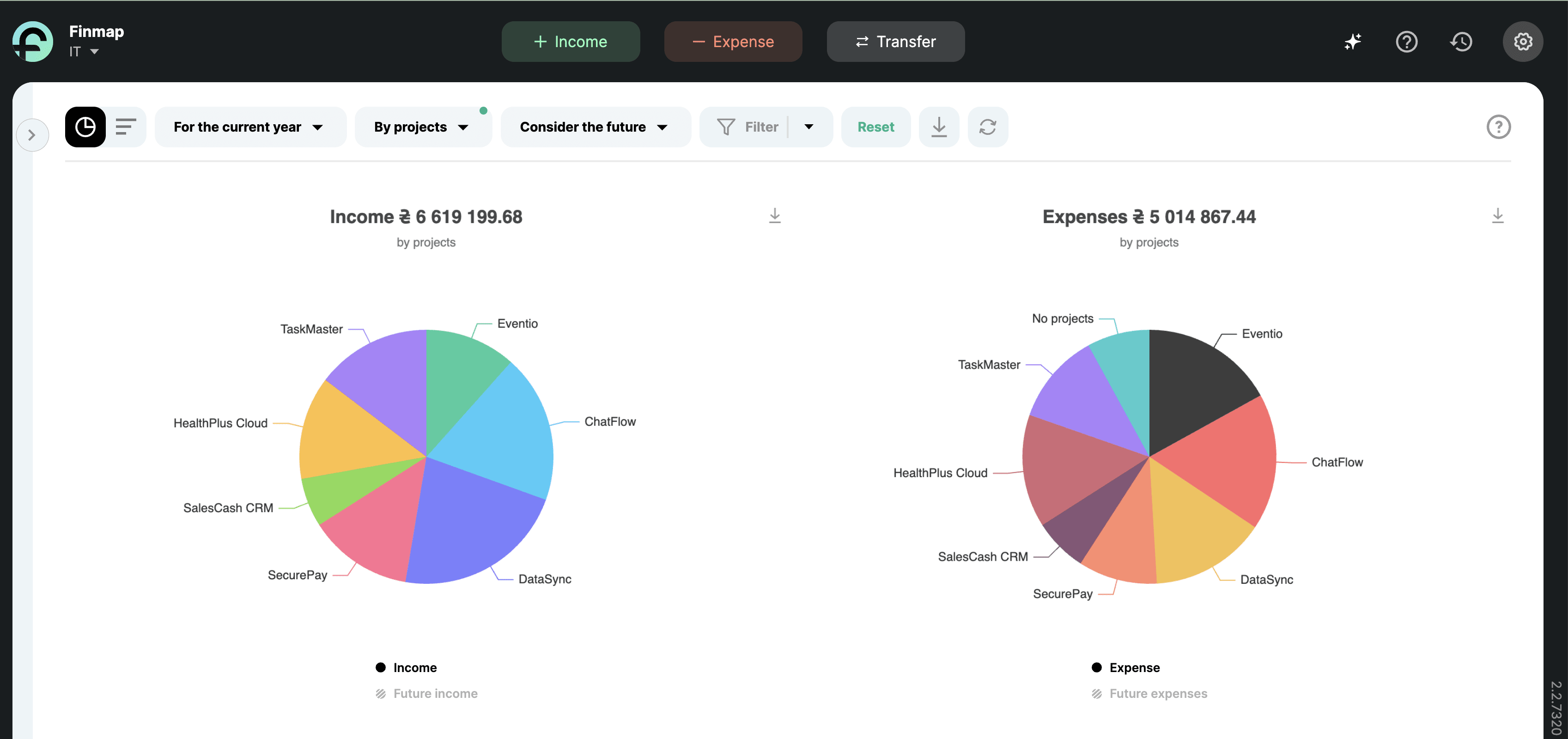
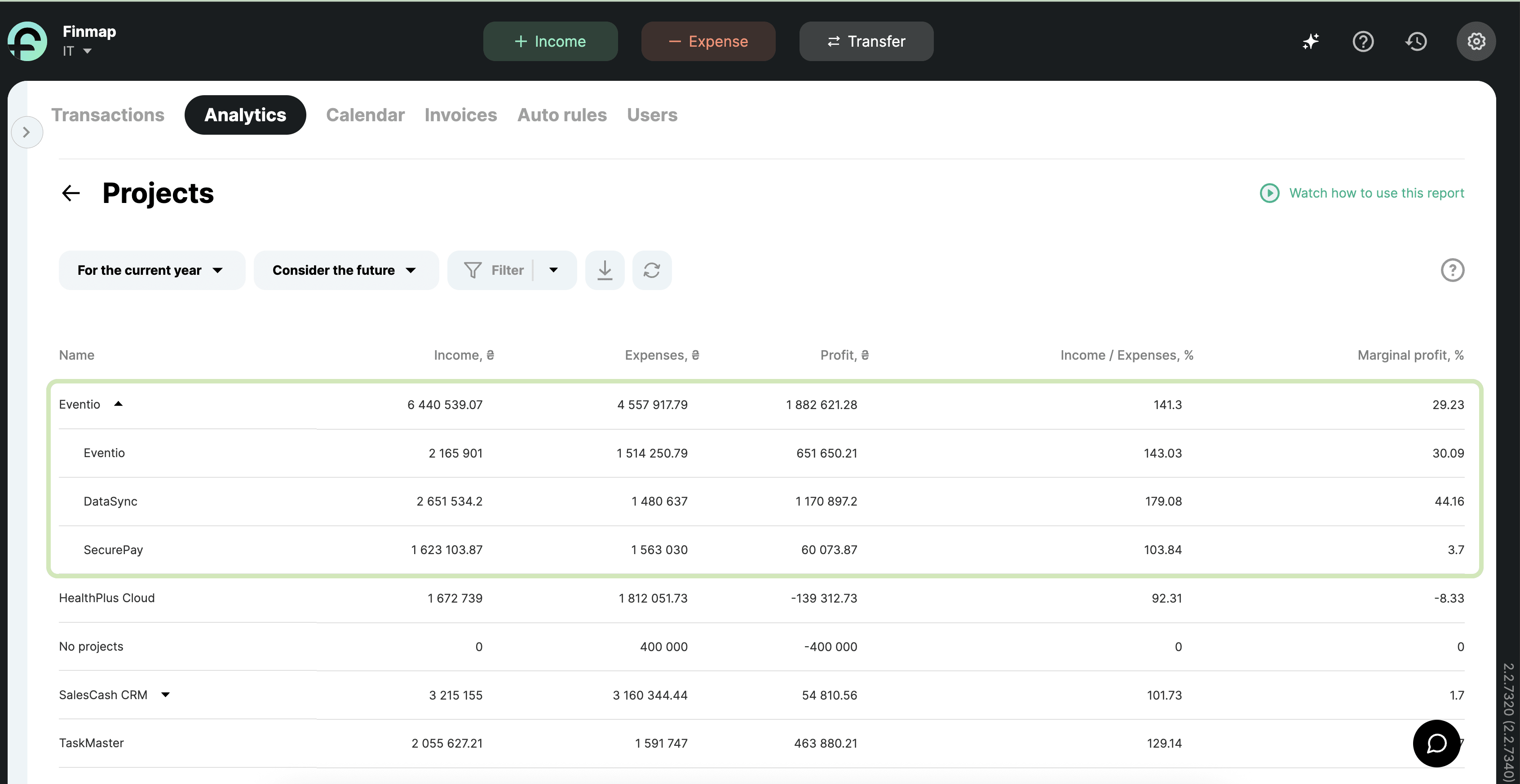
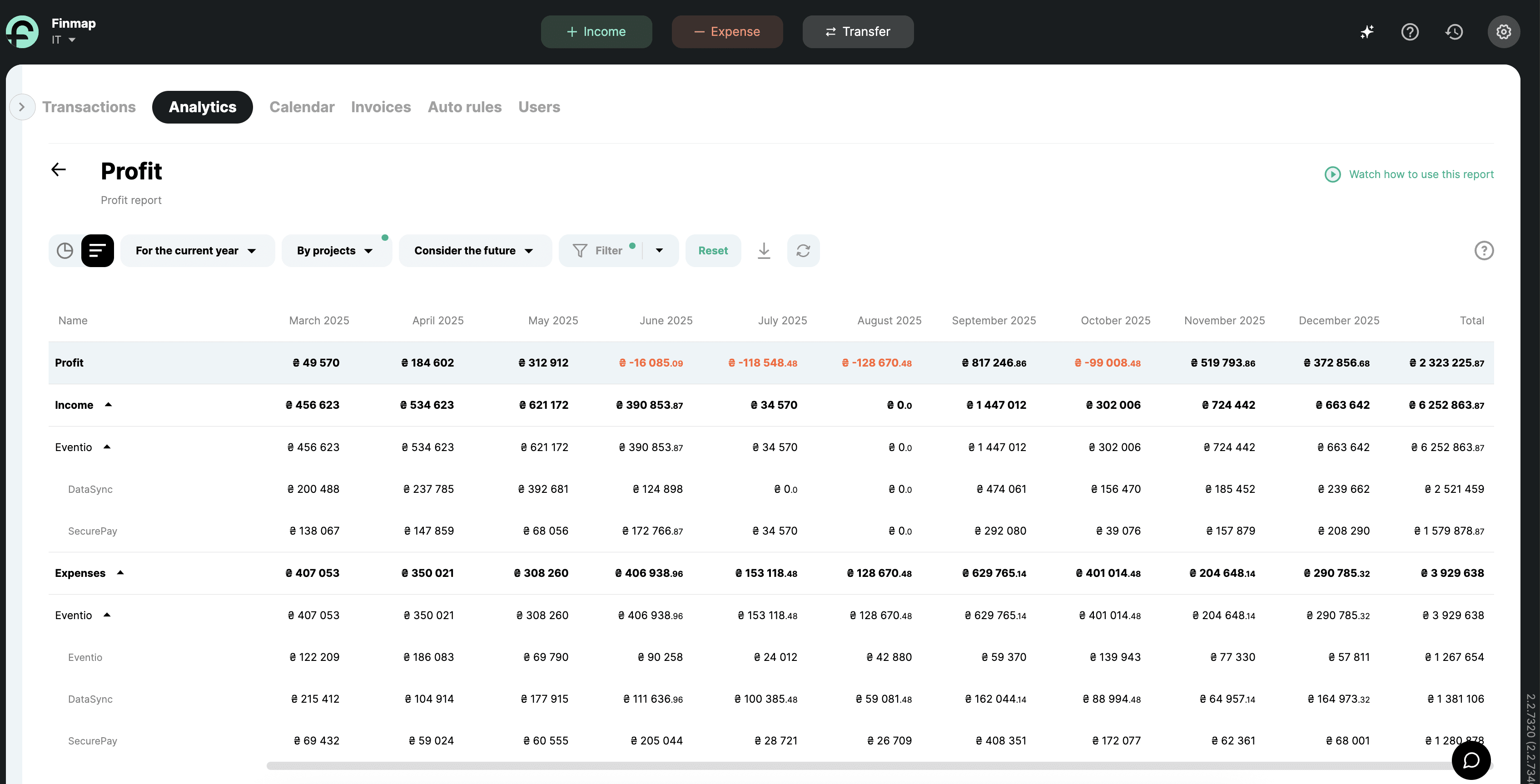
This means you’re not just looking at numbers — you see the real financial picture of each project. And you can make decisions not based on intuition, but backed by real data.
Profit in One Currency, Losses in Another: Why Multicurrency Financial Management Is Critical
Income in dollars, expenses in euros, salaries in USDT, and reserves stored in crypto or pounds. This isn’t a hypothetical scenario — it’s the daily reality for most IT companies working with clients and teams across the globe.
The result? Multiple parallel financial realities:
- everything looks fine in the UAH report, but the USD version shows losses;
- a profitable contract gets eaten up by exchange rate fluctuations;
- plans collapse due to a single miscalculated transfer or a delayed payment.
Without multicurrency financial management, a company can’t see the true state of its finances.
This is especially critical for businesses that:
- Work with clients in different countries (payments in USD, EUR, PLN, GBP);
- Pay teams and contractors in their local currencies;
- Hold accounts in several countries or use multi-currency cards and wallets.
When there’s no multicurrency financial management — profit becomes relative and forecasts lose meaning:
- What looks profitable may be just an illusion — it all depends on which currency you’re calculating in.
- Exchange rate fluctuations can wipe out the margin you thought was stable.
- It’s hard to plan cash flow when every transaction requires conversion and cross-checking against the central bank or interbank exchange rates.
Practical Solutions for Multicurrency Financial Management in an IT Company
Error-Free Multicurrency Management: How It Works in Finmap
If you’re managing multicurrency operations in spreadsheets — that means constant manual work, a high risk of errors, and distorted analytics. We recommend choosing a system that automatically pulls in exchange rates, matches transactions, and generates up-to-date financial reports on its own.
In Finmap, for example, multicurrency isn’t a standalone feature — it’s built into the core logic of the entire system.

You сan:
- Manage finances in any currency — across accounts, projects, transactions, and reports.
- Set a base currency to view the full financial picture — for example, see everything in USD, even if some expenses are in EUR or PLN.
- Enter exchange rates manually, pull them automatically from the central bank, or use the actual rate from the transaction.
- Track exchange rate differences in operations — and calculate their impact on profit or reserves.
- Manage not only fiat accounts, but also crypto wallets — for example, keep reserves in USDT, BTC, or ETH and see them reflected in your overall financial picture.
When your business operates across multiple countries and currencies, precision in financial management becomes critical. And it’s accurate multicurrency tracking that allows you to analyze cash flow in a complete and meaningful way.
Hidden Costs — A Test of Your Company’s Financial Maturity
In the IT business, the team is the biggest expense — and at the same time one of the least transparent.
Core team, freelancers, agencies, support staff, plus temporary tech consultants, designers, or managers. They may all be working on different projects — but in your records, it’s just a line called “Payroll expenses.”
The result? A project might appear profitable — until you realize the team spent 120 hours on it, paid by three different contractors in three different currencies.
And then there are the costs that completely fall off the radar:
- subscriptions to services no one uses anymore (but are still billed monthly);
- one-time bonuses, branded merch, gifts, informal team expenses;
- corporate parties, celebrations, spontaneous business trips, coffee machines, certificates, and more.
WIRED reports:
Around 50% of software licenses in IT companies remain unused, and another 8% are used less than once a month. This creates hidden costs and reduces overall profitability.
Now imagine — how many other overlooked details are silently eating away at your profit?
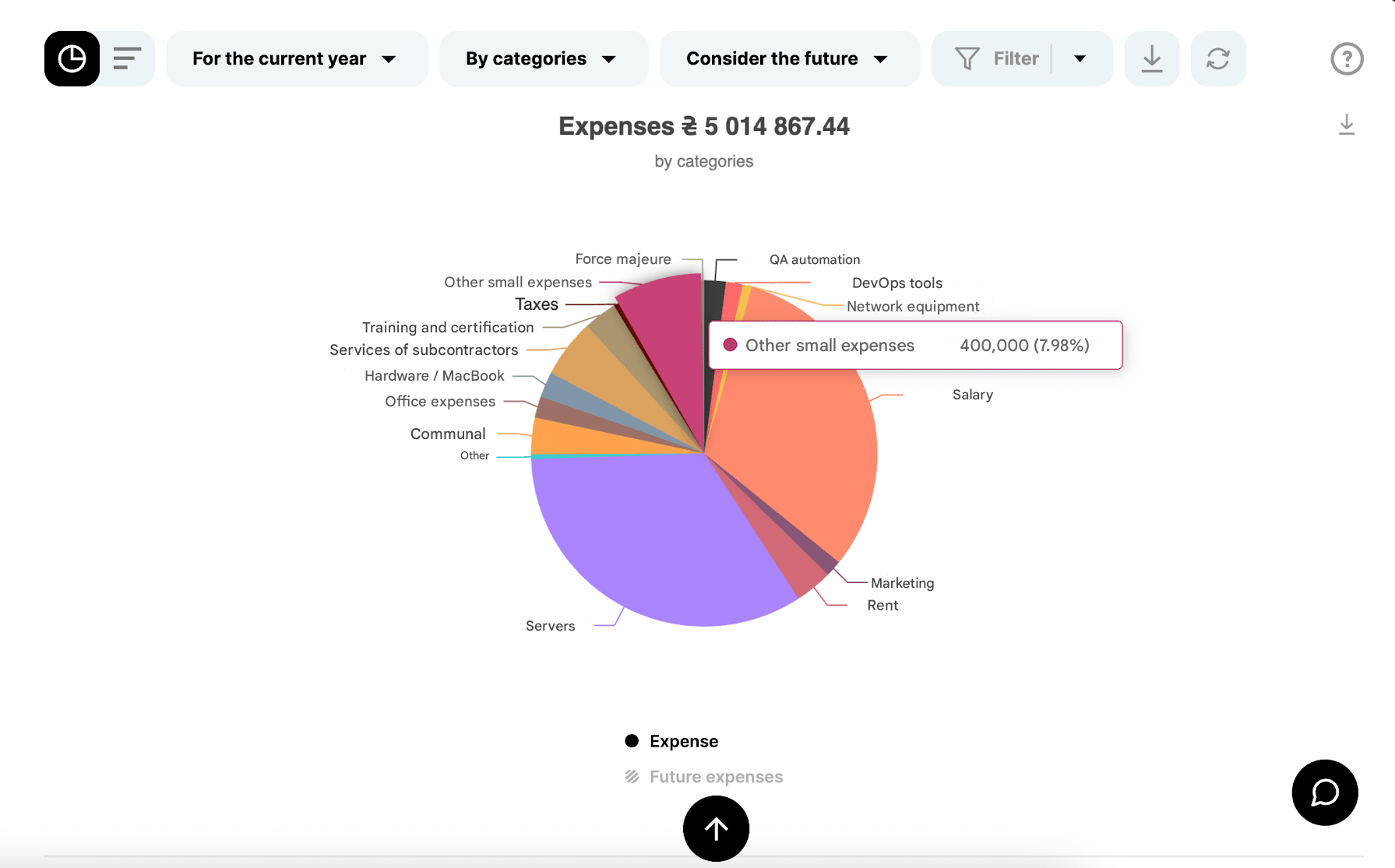
To avoid losing profit on the little things, it’s worth checking the main risk areas.
Use this checklist with control questions to uncover what usually remains hidden.
Checklist: How to Detect Hidden Costs in an IT Company
If, after going through the checklist, you’ve spotted potential “leakage points” — don’t ignore them.
Solving most of these issues starts with reliable financial management.
How to Bring Order to Your Finances with Finmap
Finmap was built exactly for situations like these — when expenses are scattered, some are hidden, and financial decisions are made on intuition.
Instead of chaos in Excel or banking apps, you get a single system that consolidates all your data: transactions, contractors, subscriptions, compensations, fines, cash flow, budgets, and analytics.
How to Organize Your Company’s Finances in 7 Steps
What an IT company gains by following these recommendations:
- Clear understanding of the current financial state — how much money is available right now, in which currencies, and in which accounts.
- Full control over all expenses — even those that previously “slipped through” (subscriptions, cash, services without integrations, bonuses, etc.).
- Transparency across projects and clients — see which areas are profitable and which are just draining resources.
- Automation of routine processes — less manual input, more time for analysis.
- Team involvement in financial management — expenses are recorded quickly and on time, not “recalled at the end of the month.”
- Ability to react quickly to financial risks — thanks to reports and analytics, the company spots trends before a cash gap occurs.
- Readiness for scaling — financial management adapts to team growth, the number of projects, and currency complexity.
Try going through these steps yourself — and you’ll see how quickly “leakage points” show up, even in a well-organized business.
Finmap Client Case: SITNIKS CRM
SITNIKS CRM is a Ukrainian SaaS company that develops CRM solutions for online stores and marketplaces.
The team was growing rapidly, expanding into new markets, and building out a product line. But scaling required resources — and without external investment, it became impossible.
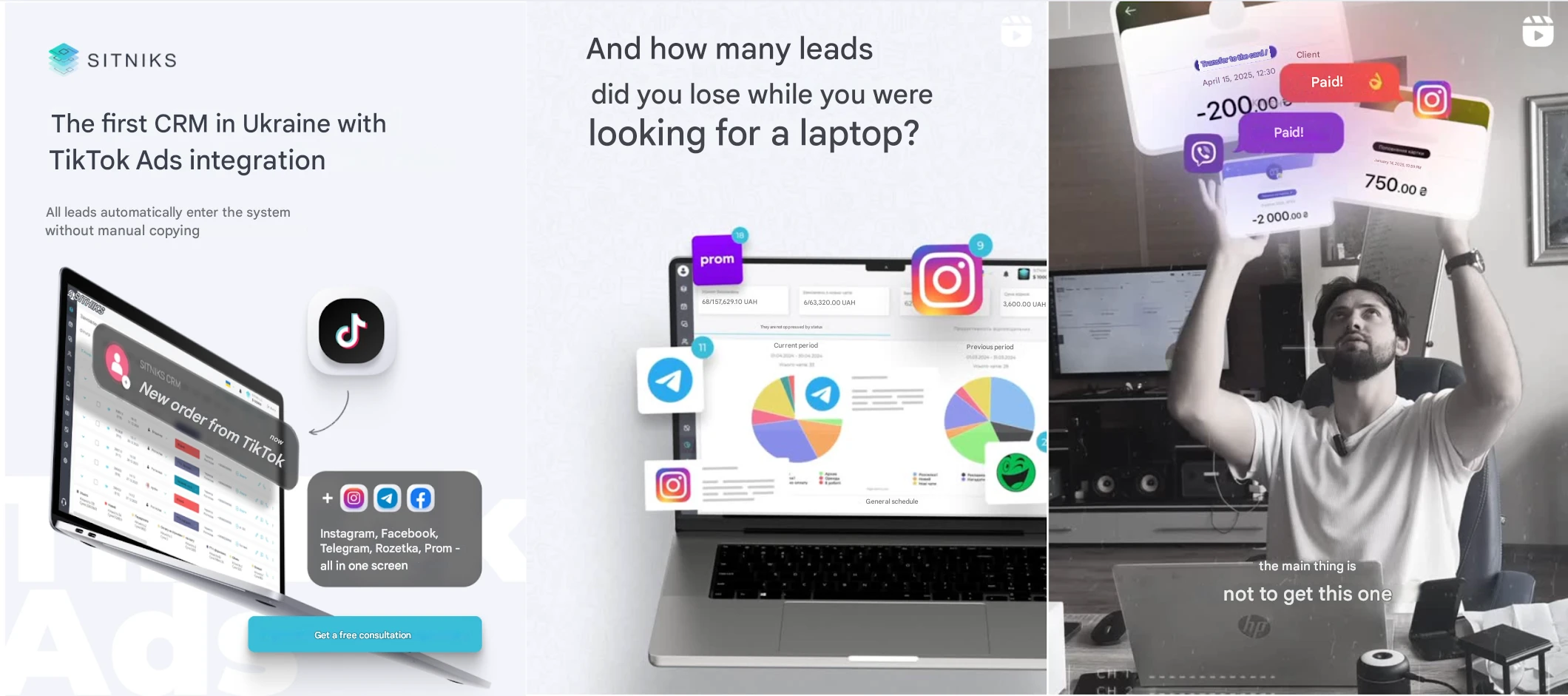
SITNIKS CRM had no problem shaping a clear vision for growth, setting strategic goals, and building a product roadmap.
But financial management remained unresolved: Excel spreadsheets didn’t provide a complete picture, and a manually compiled P&L didn’t meet investor requirements. That’s why financial order and strategy became a critical part of preparing for fundraising.
Research shows that:
75% of investors don’t consider business plans without a clear financial forecast. Companies with structured financial management and strategy gain a significant advantage when applying for investment.
— Data from Investopedia
How SITNIKS moved from Excel and chaotic spreadsheets to a transparent financial system that helped attract investment — read in the full case study.
Results of Implementing Finmap
After adopting Finmap, the SITNIKS CRM team for the first time gained a clear financial view of the business broken down by products, teams, and periods.
Based on this data, the company built a financial model that became the foundation of its investor presentation.
For the first time, they had clear answers to key questions: What the real profitability is? How much funding is needed for growth? How long the business can operate without additional capital injections?
And it was this preparation that helped secure the first round of investment.
Survival or Scaling — Financial Management Decides
The faster your IT business grows, the more expensive financial mistakes become. A missed subscription, an unprofitable project, a sudden cash gap — none of these are about luck, they’re about management.
Finmap helps bring order to your money, build systematic financial management, and make decisions based on real numbers. That’s how those who plan not just to survive, but to scale, operate.
Want to see how this would look for your company?
Try Finmap in action — and see the finances of your IT business in a whole new way.
No confusion, just numbers, clarity, and a solid financial foundation for action.
Frequently Asked Questions
1. How can I tell which project is profitable and which one is dragging the business down?
Implement project-based financial management: allocate expenses (salaries, freelancers, marketing) to each project or client. Analyze profit by stream, not just overall revenue. This allows you to focus on efficient projects and cut the unprofitable ones.
2. How do I manage cash flow when income and expenses are in different currencies?
You need a centralized system that records all transactions both in their original currency and in the company’s base currency (e.g., USD or EUR). The exchange rate must be fixed at the time of the transaction — this way you can realistically assess profitability.
3. How do I track project financial results and the impact of changes on profitability?
Record not only actual but also planned income and expenses for each project. This allows you to create a budget, track variances, and model scenarios — for example, how increased costs or delayed payments would affect results. Such an approach lets you make decisions before losses even appear.
4. How can I identify where the business is silently losing money?
Conduct an audit of hidden costs: auto-payments from old subscriptions, unapproved team expenses, forgotten freelancers, fines, discounts, staff turnover. Even isolated cases can add up and eat away at profits. Regular expense reviews are a simple way to return money to the business.
5. How do I build management reporting if I don’t have a CFO?
Start with the basics: P&L (profit and loss), Cash Flow (money movement), and account balances. Update them regularly — weekly or monthly. Even a simple Excel file or automated template will help you make informed decisions instead of relying on intuition.
.webp)
Financial Management for Design Firms: Bogdanova Bureau Case
A practical case study on how finance has helped a project business grow. Using the example of an architectural studio, we show how numbers can become a driver of profit, stability, and scaling.
Money disappears unnoticed — in deadlines, in revisions, in “portfolio” projects. And without a financial system in place, it’s hard even to know where.
This case is about an architecture studio that refused to work blindly, implemented financial management, and within a year achieved +173% in revenue and +286% in net margin. For more than six years, Finmap has been helping the team make data-driven decisions.
Not myth, not luck — but systematic work with finances.
Time to check: do your projects actually make profit, or do they just look good?
Bogdanova Bureau — Architecture, Design & Creative Solutions
Bogdanova Bureau doesn’t just create architectural designs — it builds holistic living spaces around the client. Their focus is on private and commercial properties, interior design, product design, and art direction.
The team guides each client from idea to realization with confidence and attention to detail. For founder Olha Bogdanova, creating a space should be an exciting adventure, not a source of stress.

How Finance Became Part of the Architectural Process
In 2018, after splitting off from a large architecture firm and starting her own business with a small team, Olga decided to take control of all processes into her own hands.

Right from the start, she decided that finances must operate as precisely as technical drawings.
In her previous company, they’d already used Finmap for financial management — but a dedicated accountant handled it. That experience proved to Olga that the program really works, so the choice was obvious.
She signed up for a trial period, learned the workflows, and then engaged a Finmap financial consultant. Olga knew that for management to serve as a strategic tool — not just a formality — she needed outside expertise and a professional point of view.
From her own experience, Olga understood that:
- Without financial management, even the most interesting projects can “eat up” profit.
- Creative freedom really means financial confidence.
- Making decisions blindfolded isn’t a strategy.
On short-term projects, it’s easy to allocate finances. On long-running ones it’s much harder: you have to track hours, reconcile balances and cash flows, and constantly log small expenses. — Olga Bogdanova, founder of the Bogdanova Bureau
When Basic Financial Management Isn’t Enough
By then, Olga had plenty of business experience — the chaotic “all incoming money is our profit” phase was long behind her.
Many people don’t like finance, but it’s fundamental. It’s vital to keep an eye on it. If you don’t learn to love finance, finance won’t love you. — Olga Bogdanova, founder of the Bogdanova Bureau
She clearly saw: if you want to scale, you must bring order to your finances — and not just implement management, but use the numbers as a decision-making tool.
She faced concrete tasks:
- Calculate project cost. “Sometimes a project seems to go perfectly — especially if you have a great relationship with the client. But when you look at the numbers, it’s disappointing,” Olga says. She needed to know exactly where and why the business was losing profit so she could act in time.
- Systematize expenses.
Identify unnecessary costs, recurring payments, and optimization opportunities — to reallocate resources and spend smarter.
- Implement proper managerial management. Not just logging cash movements, but to:
- dive deep into Finmap’s capabilities;
- configure the system for her specific needs;
- test hypotheses and see results in numbers;
- have an expert advisor on financial matters.
A New Level: Why Every Business Needs Its Own Financial Expert
Olga began using the program herself — uploading data, setting up integrations, exploring the analytics. But once she saw what insights Finmap could deliver, new questions emerged. She needed to dig deeper.
That’s when she decided to bring in a Finmap financial expert.
This wasn’t a “formal upgrade” — it was a logical step, perfectly aligned with the studio’s growth pace.
Once we started working with an expert, that became the real turning point and the beginning of our friendship with finance. Finmap alone is great. But when you have someone who helps you make sense of it all and systematize everything, you save money. — Olga Bogdanova, founder of the Bogdanova Bureau
From day one of that collaboration, Olga could:
- delegate routine tasks (data entry, reconciliations, categorization);
- focus on strategy — analysis, ideas, decisions;
- get answers to “what if I do this — how do we account for it?”;
- discuss hypotheses with a specialist who’s seen finances across many businesses and brings fresh ideas and approaches.
Which Financial Solutions Work at Bogdanova Bureau
Financial management at Bogdanova Bureau quickly grew from a mere control tool into part of strategic management. Each new measure responds directly to business needs. Every result is clearly measured in numbers.
1. Hourly Model: Clear Mathematics, Not Guesswork
To price orders fairly and ensure precise payment for work done, they decided to break projects down into tasks and hours. This approach lets them react swiftly when a client requests extra revisions — they already know how much time it will take and what it will cost.
2. Each Client as a Separate Project in Finmap
For a project-based business, this is a must-have: in Finmap, every client is set up as its own project. All income and expenses are recorded separately, and the analytics provide a full picture of profitability, ROI, and financial outcomes.
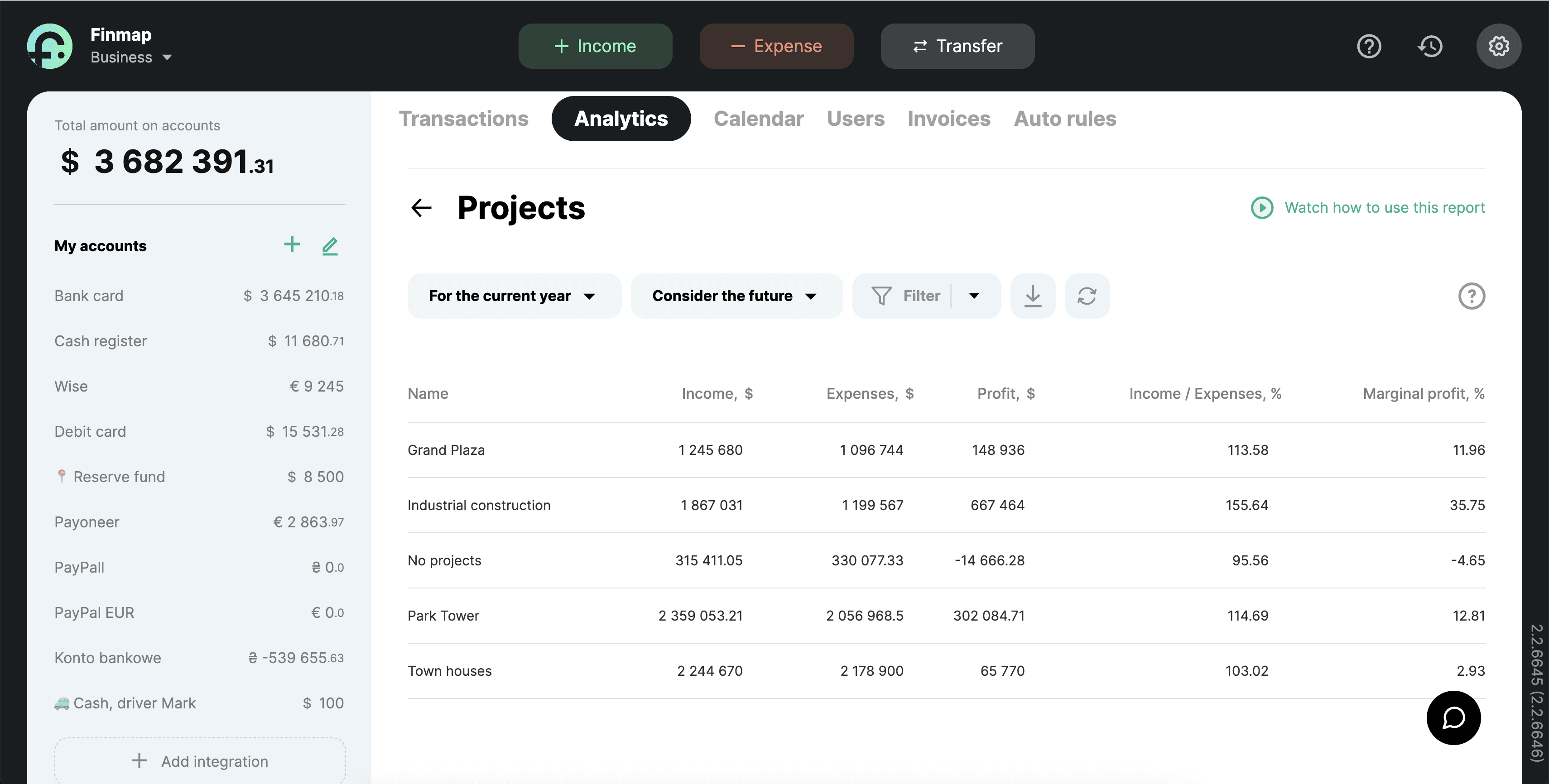
3. Funds System: Financial Flexibility and Stability
When the studio switched to remote work, they temporarily stopped spending on the office. To prevent those savings from “dissolving” into ongoing costs, they decided to channel them into an internal fund.
That created the first financial reserve — and later they added several targeted funds:
- Rent Fund – allowed stress-free leasing of the perfect office when the team returned onsite.
- Contingency Fund – automatically sets aside 2% of every receipt for errors or emergencies.
- Development Fund – investments in training, professional trips, and new opportunities.
- Marketing Fund – ensures a systematic approach to promotion and new client acquisition.
Thanks to this, the team isn’t at the mercy of circumstances — they build their own reserves, control fund allocation, and make decisions from a position of stability, not stress.
4. Analytics & Experiments: Data-Driven Decisions
New ideas at Bogdanova Bureau aren’t rolled out at random — each is tested as a distinct financial experiment. This lets them evaluate not only the creative value but also the economic feasibility of every initiative.
.webp)
5. Tracking Even the Smallest Expenses
Recurring service fees, subscriptions, and software costs often stay “invisible” to the business. Individually they seem minor, but over a year they add up.
$7 per month becomes $90 per year. And it’s not just one tool. In Finmap this is tracked brilliantly — you see exactly where your budget goes. — Olga Bogdanova, founder of the Bogdanova Bureau
Finmap lets you plan your budget with precision and avoid hidden cash leaks.
How Finance Became a Source of Strength, Not Stress
Thanks to Finmap, the Bogdanova Bureau team began to manage money strategically: counting, planning, forecasting.
- Systematic financial management. Finance at Bogdanova Bureau is no longer a standalone function but part of the company’s mindset. All cash flows, revenues, expenses, and projects are structured and under control.
For me, Finmap isn’t about forecasts; it’s about analysis. When you see the results in front of you, when you see where you shouldn’t spend more and where we’re losing. — Olga Bogdanova, founder of the Bogdanova Bureau
- Financial modeling and analytics. Olga builds financial models, analyzes profitability, and makes decisions based on data rather than gut feeling.
- Financial funds – reserve, development, marketing. Thanks to the fund system at Bogdanova Bureau, financial confidence emerged: money doesn’t just sit idle; it works toward specific goals.
- Clear economics of every project. Costs are calculated, prices justified, profitability measured. No more situations where one project’s losses are covered by another’s income.
Previously, we often operated at the expense of loans from other projects, dragging projects into the red. Proper financial management helps us see all this, save, and generate income where we didn’t even expect it. — Olga Bogdanova, founder of the Bogdanova Bureau
- Profit and dividends – without harming the business. Olga knows exactly when and how much can be withdrawn from the company without creating cash gaps or undermining operations.
- Personal growth of the founder. With the support of a financial manager and continuous learning, Olga has grown significantly in financial competence — and now makes decisions from an expert standpoint.
Over this time I’ve grown tremendously in financial management because the financial manager helped me set everything up correctly and systematize everything. — Olga Bogdanova, founder of the Bogdanova Bureau
Financial Resilience and Expansion to the International Market with Finmap
Financial management isn’t just about spreadsheets — it’s about decisiveness, system, and confidence, even when everything around you changes.
Systematic Approach That Delivered +173% Income
After deploying Finmap and a comprehensive finance system that covered every project, expense line, and forecast, Bogdanova Bureau achieved remarkable results.
The team analyzed profitability across divisions, dropped low-margin projects, and focused on those that truly generate income.
This not only boosted revenue by 173% but tripled net margin.
Now we can see profitability before a project even kicks off. We make proactive decisions based on calculation, not intuition. — Olga Bogdanova, founder of the Bogdanova Bureau
A Safety Cushion That Withstood the Toughest Crisis
The onset of full-scale war paused the entire economy. But thanks to pre-built reserve funds and flexible management, the company adapted by:
- optimizing expenses;
- reshaping the team;
- reallocating budgets;
- keeping projects in progress.
Bogdanova Bureau stayed afloat not by chance but by design. Their financial cushion bought them the time and space for measured decisions at the hardest moment.
A Bold Entry onto the Global Stage
The crisis became both a challenge and a catalyst. Leveraging analytics, forecasts, and clarity about their strengths, Bogdanova Bureau stepped onto the international arena.
Today they boast successful projects outside Ukraine, stable work with foreign clients, and a steadily strengthening position in a competitive new market.
Our focus now is fewer projects but bigger, more complex, and more profitable ones — backed by financial control that holds firm even in crisis. — Olga Bogdanova, founder of the Bogdanova Bureau
Changes Begin with Decisions
Olga journeyed from chaos to a clear system — and she did it not by hiring a large finance team, but by using the right tool, expert support, and recognizing the value of financial management.
Finmap became not just an management service but a true financial partner in growth.
You can too:
- systematize your financial management,
- uncover real profit and leak points,
- stop making decisions based on gut feel.
And most importantly — don’t face it alone.
Want to bring the same order to your business finances? Submit your request, and our expert will show you how to tailor it exactly to your processes.
.webp)
Project Profitability: Financial Management in Construction
The article discusses how profitability is a key performance indicator that allows managing business lines and increasing business profitability
Finance doesn’t forgive assumptions. If you’re keeping records with a “I’ll write it down later in my notebook” or “I’ll just remember it” approach, get ready for financial chaos.
One account, multiple directions and clients — and suddenly you no longer understand what’s bringing in profit and what’s just draining resources.
How can you detect in time that one direction is consuming all your profits? Without a clear management system, you risk not noticing how the money is simply disappearing and the business is heading toward financial disaster. Let’s figure out how to spot the problem early and take control of your finances before it’s too late.
Multiple Directions — One Answer: Calculate Profitability
If you have several business directions, you’re no longer just an entrepreneur — you’re the owner of a portfolio of mini-businesses. And each one has its own economy. The only question is whether you can see it.
To understand what’s truly working, you need to calculate the profitability of each direction separately.
Profitability isn’t just a percentage in a report. It’s an efficiency indicator that shows how productively a business uses its resources to generate profit.
The most important type is usually considered to be sales profitability, and the higher the figure — the better the company controls its expenses:
Profitability = (Profit / Revenue) × 100%
For example, if you earned $80,000 in revenue from a certain project, and the net profit from this direction was $20,000, then profitability is calculated as follows:
(20,000 / 80,000) × 100% = 25%
This means that each dollar earned brings in $0.25 in net profit.
.webp)
.webp)
.webp)
.webp)
If you understand profitability and know how to “read” it, the question “where to find money?” solves itself.
Because if one direction brings only 5% profitability, while another brings 28% — that’s a clear signal where to invest more time and resources, and what to stop before it’s too late.
When There’s a Business but No Money — the Problem Is Not the Market, It’s the Financial Management
Management by profit centers is not a whim, but a survival tool. If you don’t see profitability separately, it means you’re not managing the business — you’re just reacting to problems after they arise.
With this understanding, the owner of a construction company offering several types of services turned to Finmap.
The company is involved in construction, performs renovation work, and sells building materials. Each of these directions has its own clients, contracts, and payments.
However, there was no talk of financial order. The owner complained that in some months, his foremen were earning higher salaries than he could take out as dividends.
Sometimes at night I’d lie in bed and spend half the night trying to piece together the full picture in my head, to understand what I was doing wrong. Maybe someone else would have already shut everything down and gone back to doing regular renovations. But I couldn’t just give up! — Owner of a construction company
To move forward, it was necessary to optimize processes and clearly define key financial indicators. The company owner identified several mandatory points he wanted to track:
- Profit and profitability of each direction. It’s important to be able to open a report, for example, for “Construction,” and clearly understand the revenue, expenses, margin, and profitability of that direction. This helps assess whether it’s worth continuing to operate in that area.
- Results by each client and project. It’s essential to see which orders don’t bring profit and whether it’s necessary to adjust pricing for construction and renovation services to avoid loss-making contracts.
- Overall results for the entire company. The ability to determine how much profit can be directed to dividends and how much should be reinvested in business development.
- Optimization of petty cash processes. Foremen constantly handle cash, and tracking expenses that occur multiple times a day without a proper system is extremely difficult. It was necessary to implement a mechanism that allows easy control of these expenses and ensures transparency.
Due to lack of time for developing and creating complex Excel spreadsheets, Finmap’s automated solutions became the optimal choice for effective financial management.
How Finmap Helps Structure Finances and Make Strategic Decisions
The experience of the construction company proves that when a business develops in multiple directions, financial management without a system can easily turn into chaos. Below is a brief overview of key solutions that transformed internal financial management within the company.
Three Directions — Three Separate Financial Realities
Finmap’s financial management system includes a dedicated feature for separating business directions — Projects. This entity can be used to tag not only types of activity but also the cities or countries where the business operates, locations, sites, orders, etc.
The company divided its activity into three main directions:
- Construction
- Renovation work
- Sale of materials
Each payment was tagged with a project — manually or using auto-rules. After a few weeks, the system gathered a full picture — profit and automatically calculated profitability for each direction are now tracked in real time.
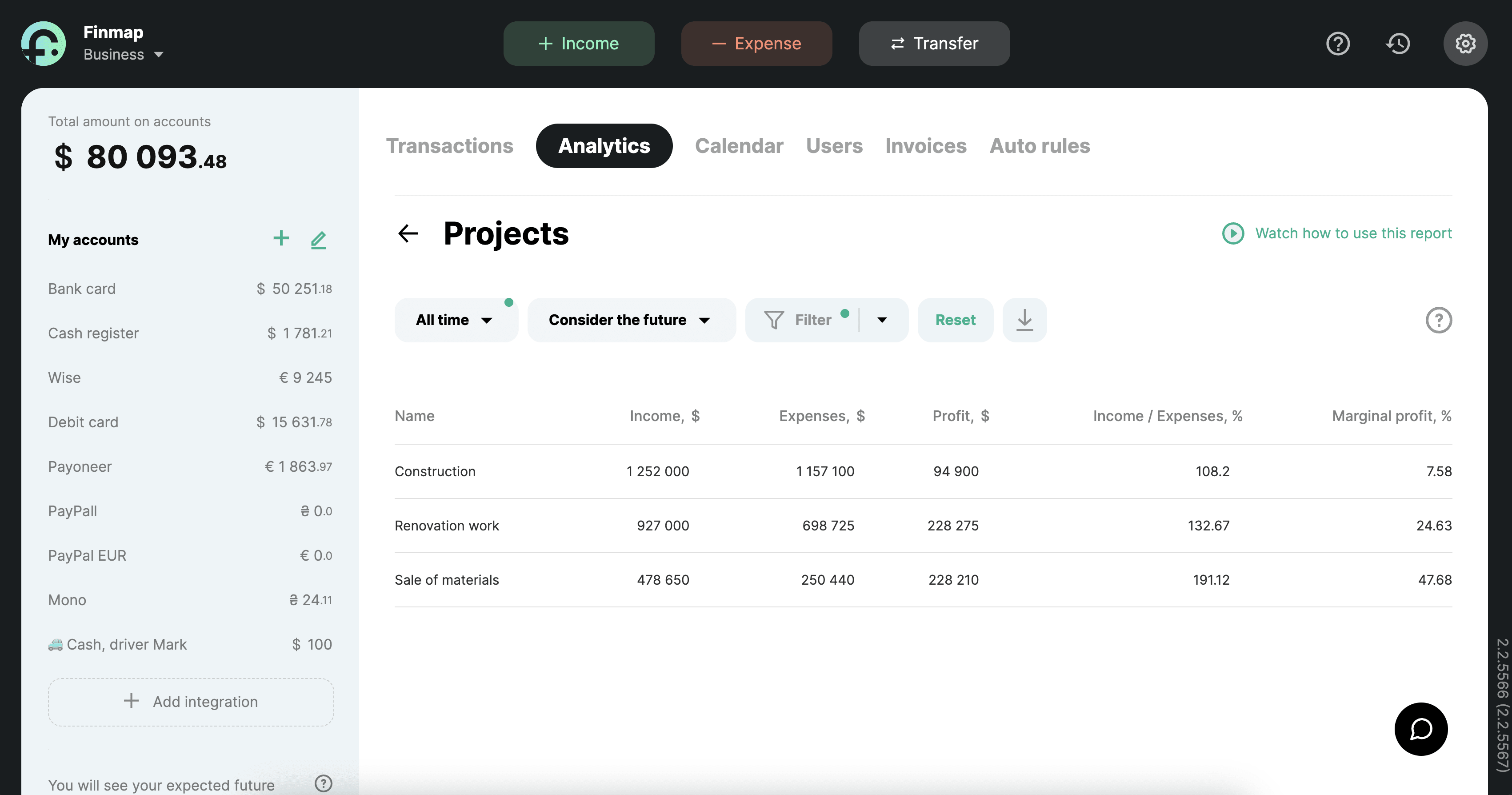
How to Ensure Full Analytics by Client
In addition to Projects, payment records also include tags — names of the sites and locations where the crews are working. This allows the company to, within seconds:
- filter all expenses and income by a specific client or site;
- see how much each object generated;
- generate a report with the desired level of detail.
A pleasant bonus was the ability to plan all inflows and outflows by project and not only see the current budget status but also forecast the future result.
The “Profit” Report: Strategic Decisions, Not Gut Feeling
Once financial management was implemented, the P&L report became the main source of answers for the owner:
- What is the company’s real profit?
- How much in dividends can be withdrawn now — without harming future periods?
- Which project is worth scaling?
- Where are we losing margin, even though it seems like “everything’s fine”?
Custom reports were also created based on saved filters. This detailed the financial results of each project. Now the owner has well-founded information on the profitability indicators of each of them.
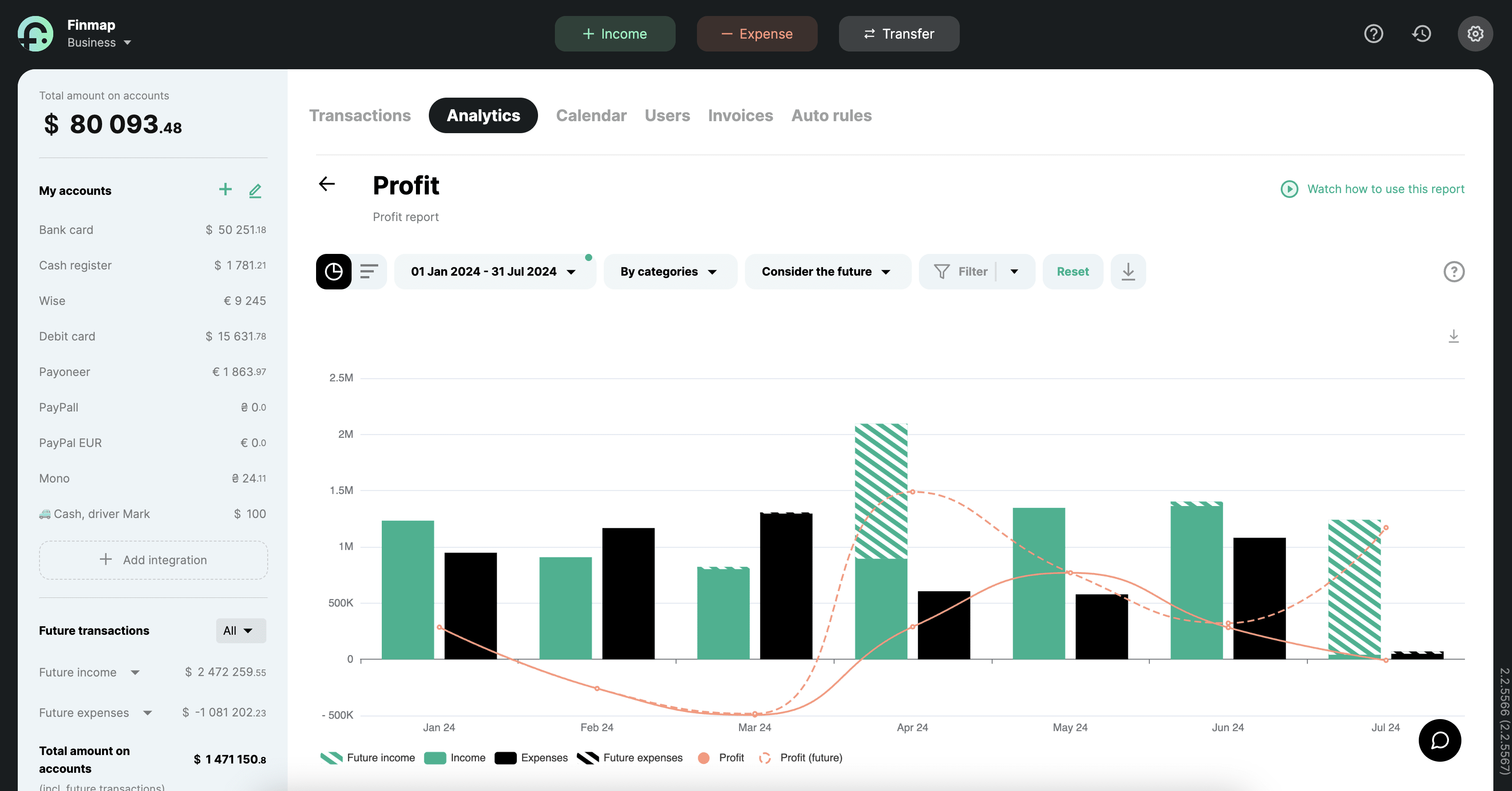
Petty Cash Without Chaos: Mobile Apps
The issue of petty cash was resolved in a very sustainable way. A separate account was created for each foreman. No access to the company’s general budget — only to their own accountable funds.
Employees no longer struggle with reporting, as they can now enter the expense right away in the mobile app, attach or take a photo of the receipt, and not worry that a purchase might be forgotten.
Result:
- less stress for employees;
- a complete financial picture for the manager;
- zero losses and confusion.
This solution not only improved financial management but also reduced tension within the company. The foremen don’t spend time after work or on weekends — they enter the data immediately while on-site, which is convenient for both staff and management.
This case is not an exception — it's an example of how proper financial analytics transforms business management.
Finmap didn’t just gather numbers in one place — it gave the owner a clear understanding of what’s working and what’s dragging the business down.
While others rely on gut feeling, this company makes decisions based on facts. Because business is not a game of chance. It’s about control, structure, and confidence in tomorrow.
Want to make well-grounded decisions instead of relying on luck? Work with numbers — work with Finmap.
.webp)
How Financial Management Drives the Success of Marketing Strategies at "Marketing Office"
How to develop and implement an effective marketing strategy with the help of well-established financial management in Finmap
It's a mistake to think that financial management is a tool only for the owner or manager of a company. In fact, it is a red thread that runs through all departments, uniting them into a single system and ensuring effective and coordinated interaction.
In this article, we will find out why it is important for companies to have well-established financial management in terms of marketing and marketing strategies. The example will be one of Finmap's partners, the Ukrainian digital company "Marketing Office", which provides comprehensive marketing services.
Financial Accounting From Day One: Marketing Office's Experience
"Marketing Office" was founded several years ago. The founder, Alina Kashapova, took a responsible approach not only to the selection of the team, but also to financial management from the very first days of the agency's existence. She had to work with companies that had not implemented financial accounting for decades, which caused constant problems in business and marketing.

Why Effective Marketing Requires Financial Management?
Financial accounting helps to make management decisions based on the real business situation. Without a clear financial record of income and expenses, it may seem that there is an opportunity to invest more in marketing to attract new customers. But a one-time injection of funds into marketing is not enough for stable and ongoing growth.
It must be a constant, systematic process that is adjusted and updated. For example, a comprehensive website development and promotion can take 3-4 months. The client will receive the results of this marketing move in the future, and the funds for implementation should be spent throughout the process.
"Marketing Office" emphasises:
Throwing money in and not drawing conclusions is a disservice to your business. Management of income, expenses, and financial results correlates with marketing processes.
So where do you get the money to reinvest in marketing on a regular basis?
Without a clear understanding of the company's state, a shortage of resources is unavoidable.
Only financial management can assess the state of the business and find the answer to this question. Financial accounting analytics shows:
- How much money is currently invested in marketing.
- What is the share of marketing costs in the overall structure.
- Which costs are subject to optimisation and reduction.
- Which costs are subject to optimisation and reduction.
- Whether marketing campaigns bring the desired result.
Therefore, marketing is impossible without a clear financial strategy, since it is finance that determines the opportunities for attracting customers, developing the brand and implementing strategic plans.
P&L Report: The Key to Informed Marketing Decisions
In order to avoid intuitive decisions and rely solely on numbers and facts, Marketing Office first of all refers to the client's financial statements, and directly to the P&L. If it is properly maintained and filled in, the marketing department can focus on the following issues:
1. Effectiveness of activities. The ratio of marketing expenses to company income will allow you to understand whether marketing provides an increase in new customers, whether sales volumes are growing, etc.

2. Work with the assortment. The information from the report can give an understanding of which product or service needs additional promotion or replacement; which product/service is currently relevant to the client, etc.

3. Marketing strategy. Planning the financial part of marketing allows you to predict future revenues and avoid losses. Adjustments to the marketing strategy are always based on financial results.
.gif)
Of course, in addition to these three issues, the P&L report can provide information on the trend and composition of marketing expenses, the type of customers (new or regular), the impact of sales department expenses, and much more.
Successful Business Control Through Finmap Reporting
"Marketing Office" Uses Finmap Not Only for P&L Reports. The company also actively uses the Projects report to keep track of work projects and various business lines.
Every month, we manage about 10-12 projects for clients. The more projects you have, the easier it is to get confused, so the expense accounting software makes life much easier. — Alina Kashapova, founder of "Marketing Office"
Alina Kashapova, as a business owner, constantly analyses key financial indicators to plan her business properly. The main ones are generated automatically in the Analytics section of Finmap, while the in-depth ones are calculated separately based on data from reports:
- Profit dynamics - whether the total profit is increasing according to the plan.
- KPI calculation - which performance indicators are realistic in the current period.
- Margin level - whether the margin meets the planned goals.
- Availability of free funds - whether there are funds for new expenses and investments.
- Analysis of future income and expenses - to avoid cash gaps.
Marketing and finance must work in tandem to achieve results, and regular financial management allows businesses to grow steadily and without unnecessary risks.

Financial management is not accounting, but a key element of a successful business. The use of modern tools such as Finmap helps entrepreneurs stay afloat, effectively manage financial flows, and grow.
Set up financial management with Finmap and start building a successful business strategy today!
.webp)
How the Sales Bureau Overcame Financial Chaos and Eliminated Cash Gaps: A Real Case
How did the international consulting company Andrey Krupkin's Sales Bureau successfully scale the company and forget about cash gaps with the help of Finmap
Looking at successful companies that have become key players in the market in 8-10 years and are already setting their own rules, it is hard to believe that they also started out small. Each of them has gone through a difficult individual path of development. But they all have one thing in common: they managed to establish financial management and overcome financial difficulties.
From a Single Person to an International Company
«Sales Bureau» - is a prime example of a company “that has made it”. Now a successful international consulting company, back in 2016 it started its journey with one employee and three clients. Andrii's experience, knowledge and perseverance allowed him to scale the business. However, gaps in financial management prevented the business from growing fully.

Big Bills Don't Always Mean Big Profits
The company grew, new types of expenses, accountable persons, departmental budgets, new clients with new requests appeared. Drowning in the bureaucracy that was already at the company's doorstep was not an option. It was necessary to find an easy and effective solution that would allow us to systematise the mess of amounts and numbers.
I realised around the third year of doing business that if I want to earn more, scale the company, raise salaries for people, understand how much I personally earn, and have financial hygiene, I need to understand finance. — Andriy Krupkin, founder of the «Sales Bureau»
The solution seemed obvious - to bring all financial sources into one system and streamline them.
.webp)
By connecting Finmap and adding all the accounts, it was finally possible to relax — the funds in the accounts brought a sense of calm and hope. With such amounts, financial crises seem like fleeting concerns that immediately disappear when you look at the full capital.
However, for some reason, the problems did not disappear, and more and more often cash gaps destroyed the company's plans.
We thought we had a lot of money because of the big cheques. But as it turned out, this is not yet profit. — Andriy Krupkin, founder of the «Sales Bureau»
How to Tame Chaos and Cash Gaps with Finmap
Simply bringing all financial sources into one system was only the first step on the road to financial order.
The second step was to manage receipts and write-offs, which were now in the palm of your hand. With Finmap, the cash flow process became transparent and understandable, which in turn allowed us to:
- completely abandon homemade signs;
- get rid of the chaos and confusion caused by these signs;
- unify and standardise financial management for all departments;
- control the movement of money in online time.
Andrey Krupkin, founder of the «Sales Bureau», shares his thoughts:
If you don't use Finmap, you spend a million to a billion hours summing up all your inconvenient signs, where you can't even automate any processes. Finmap solves all these issues.
With each passing day, the situation became clearer and the company realised that without effective planning, the mess would not be completely tamed. Finmap's Payment Calendar came to the rescue, showing at a glance which days payments were expected from customers and when payments were due.

Thanks to the automatic calculation, the Calendar clearly shows when there may be a shortage of money to pay contractors or employees.
So, after adjusting the payment terms and scheduled dates, cash gaps were crossed off the list of financial difficulties.
Key Insights from the Sales Office
Rational planning and the P&L report finally answered the question of where the profit was, which was hidden among a large number of transactions. Thanks to the date of the transaction and the period of the transaction, it was possible to clearly identify the money actually earned not only in terms of the year or month but even the week.
Having tamed the turbulent financial flows, the «Sales Bureau» was able to identify the following points with the help of ready-made financial reports:
- expense sources that need reduction and optimization;
- the most popular and profitable services;
- how to optimize accounts receivable;
- which business areas are growing the fastest;
- business areas that require updating and modernization.
How Finmap and the ‘Sales Office’ Are Currently Working Together
The company has now fully established financial management and automated this process using Finmap tools. Now all top managers, the COO and the founder of the company have transparent information that can be accessed from any device.
Andriy says that Finmap-based financial control has allowed him to formulate a more accurate sales strategy.
Comparing the experience of accounting at the beginning of our business and now, I am sure that we have managed to reduce the time spent on finance by 50 times! — Andriy Krupkin, founder of the «Sales Bureau»
You can also see for yourself by registering with Finmap. Set up and automate your financial accounting and don't waste time on routine
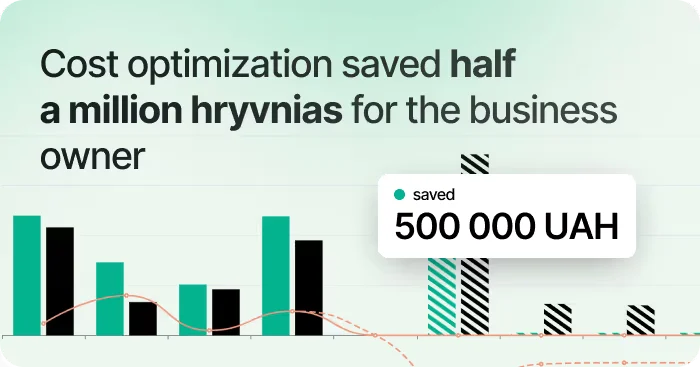
How a Service Business Owner Saved $12 500: The Financial Strategy That Worked
Lack of control over finances and unforeseen expenses can be a real Achilles' heel for every entrepreneur, undermining financial stability and reducing profitability.
Finance has always been key for me. Excel, while useful, does not always meet modern business requirements. But when we started working with more professional money accounting tools for business, everything changed. — Dmytro Sheremeta, entrepreneur, owner of Сhystota.ua
How to save $12 500 on cost optimisation
Dmytro's company delivers equipment in the form of a vacuum cleaner or a ladder for each cleaning, if necessary, which is included in the service price. They used to use taxi services, which did not provide a consistent price for the transportation of equipment: it varied depending on the weather, days of the week, and the demand for taxis at that particular time.
After analysing the costs in Finmap, Dmytro saw that they were spending an unpleasantly high price on logistics. Together with the team, they started looking for ways to reduce these costs. Eventually, they decided to completely change the type of delivery. They found a partner who delivers on electric scooters. This improved the logistics time, removed the fuel variable, and made the price stable.
One round-trip delivery cost $9 for the company, and after cost optimisation, it was $2.5.
Thanks to Finmap, we saved $9 000 on optimising the cost of equipment delivery alone. In total, we optimised costs by more than $12 000 over the year. — Dmytro Sheremeta, entrepreneur, owner of Сhystota.ua
What Finmap features help you save money?
Dmytro uses Cashflow and P&L most often. He needs Cashflow on a monthly basis to analyse the company's expenses, to quickly assess what costs they incur and to make optimisation decisions easier.
Dmytro reviews the P&L regularly, comparing it to the previous two months to identify changes in different cost categories. If he notices an increase in expenses in a certain category, the team immediately analyses the reasons for this growth and considers optimisation opportunities.
Save $12 500 or lose money? What will you choose?
The answer is obvious. But how to do it?
In the Finmap service, you can allocate all your expenses and income to separate categories, contractors, and projects.
Let's look at how it works using the example of categories.
You have fixed costs that recur every month, such as rent, logistics, advertising, etc. In the Analytics section of the Profit report, you can use filters to analyse your expenses for each period and each category.
.gif)
This way, you will see which expenses eat up a lot of your money every month. Understanding where exactly this weakness is in your budget, you can look for ways to optimise your expenses: change suppliers, give up a part of the office that is not used, etc. Thus, just by saving on expenses, you will already significantly improve the financial health of your business.
But uncontrolled expenses are not the only problem in the accounting of money for a modern entrepreneur.
What do entrepreneurs face every day?
A large number of business owners face the following problems:
- They do not see the real state of the business.
- They do not understand how much money is currently on each account and in the company as a whole, the data is available, but in a bunch of home-made tables that are difficult to analyse and almost impossible to bring together.
- They do not understand how much dividends they can withdraw without harming their business.
- Whether there will be enough money at the end of the month to pay salaries, rent and contractors.
How to solve it?
Thanks to Finmap, you can easily put your business's money in order and keep your finger on the pulse, because from now on:
- All your invoices are on one screen, clearly.
- All data gets into the service automatically, thanks to integration with banks and payment systems.
- Easy to analyse money (Cashflow), profit (P&L), projects, bills, debts: not in complex chaotic reports, but in visual charts.
- Thanks to the payment calendar, you can easily plan cash flow and prevent cash gaps.
- Delegate routines to employees, deciding who can see what and who can edit what.
- Also, you no longer need to search for invoice templates on the Internet: from now on, issue branded invoices directly in Finmap.
Don't wait until you start losing money. Try Finmap for free right now!

